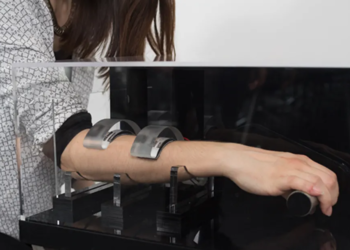Das Projekt Affordance++ zeigt eine Möglichkeit, dass Objekte und Gegenstände den Nutzern zeigen wie sie zu verwenden sind. Mittels elektrischer Ströme werden die Muskeln der Probanden zu einer Bewegung animiert.
Am Beispiel des Experiments mit der Spraydose von Pedro Lopes werden Nutzer aufgefordert, mit einer Sprühdose, eine Form auf ein Blatt Papier zu sprühen. Alle Probanden wollten sofort mit dem Sprühen beginnen. Nun wurden diese aber durch die elektrische Muskelstimulation – EMS daran erinnert, die Dose vor der Benutzung zu schütteln, damit sich die Inhaltsstoffe in der Dose vermengen. Das Design einer Spraydose animierte die Nutzer nicht zum Schütteln. Pedro Lopes hat diesen wichtigen Schritt in sein Experiment integriert, um zu zeigen, wie es gelingt, dass Nutzer von Produkten und Objekten gelernt bekommen, wie diese ordnungsgemäß zu verwenden sind um mögliche Fehler in der Benutzung zu vermeiden.
Die Möglichkeit, mit virtuellen Objekten zu interagieren zeigt ebenso ein Experiment von Pedro Lopez. Ein Spieler bewegt sich mittels VR-Brille in einem virtuellen Raum. Beim Berühren von virtuellen Wänden erfahren die Spieler durch elektrische Signale ein haptisches Feedback.
Die Aufgabe im Spiel ist es mit großen Würfeln zu interagieren und diese von A nach B zu befördern. Sobald der Spieler mit einem Würfel interagiert, wird die Masse des Würfels durch die elektrische Muskelstimulation – EMS Simuliert und überträgt sich somit auf den Spieler.
Das Projekt “Ad infinitum” von Pedro Lopez wurde im Jahr 2017 im Zuge des Ars Electronica Festivals vorgestellt. Die Installation zeigt, wie kinetische Energie von Menschen abverlangt werden kann indem mittels elektrischer Energie die Handgelenksmuskulatur stimuliert wird.
Der Proband greift nun nach dem Griff und lässt die Muskelstimulation seine Muskeln in eine unwillkürliche und automatische Kurbelbewegung führen. Diese kinetische Energie von der Kurbel wird über einen Dynamo in die Maschine zurückgeführt und zur Stimulation wiederverwendet.
Sources:
https://ars.electronica.art/festival/
http://plopes.org/project/ad-infinitum/
https://www.materialtimes.com/
https://www.mentalfloss.com/article/93736
Alexander Moser
https://www.alexander-moser.at/

